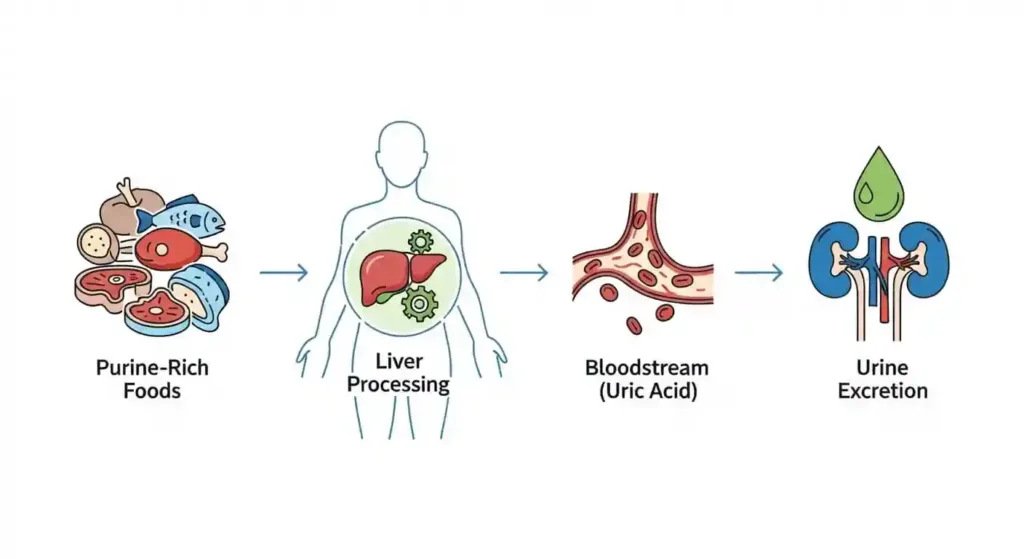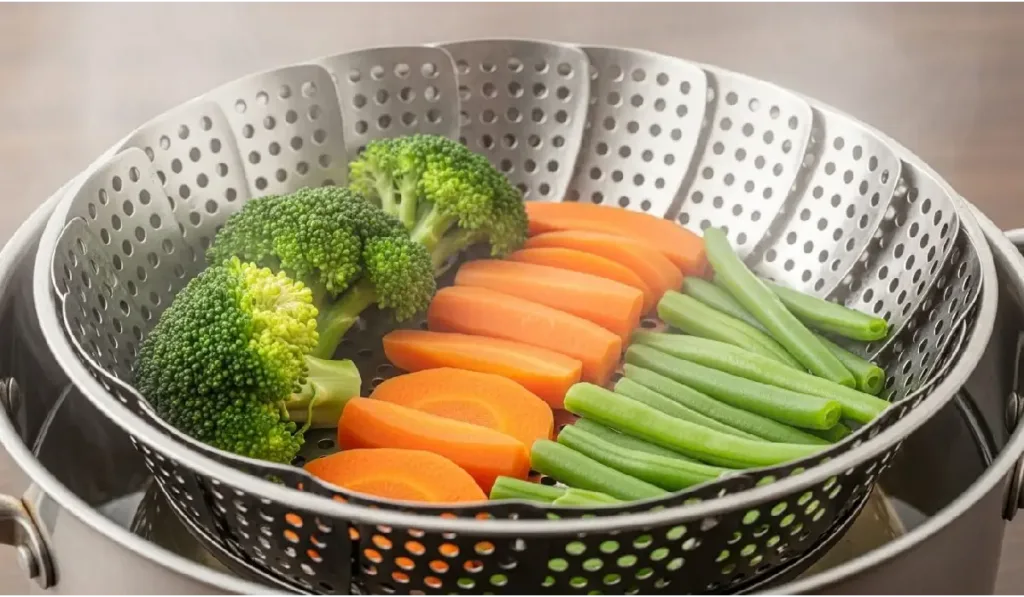You wake up one morning and feel a sharp, burning pain in your big toe. Maybe it’s your knee this time, swollen, warm, and you feel hard to move. You go to the doctor, get a blood test, and hear three words that change everything: high uric acid and you are handed a long list of foods to avoid, but no one clearly tells you why these foods are a problem or how you can adjust your diet plan without sacrificing your favorite meals.
If you’re nodding right now, you’re definitely not alone. Across India, Pakistan, and South Asia, millions of people face high uric acid levels, most of them don’t even realize it until pain suddenly shows up. With the right uric acid diet plan, you can naturally bring your uric acid levels under control, reduce inflammation, and stop painful gout attacks before they begin.
By the end of this guide, you’ll clearly understand what to eat, what to cut down, and how simple food science can transform your metabolic health. Whether you’re searching for a low-purine diet for gout or a practical uric acid control meal chart that fits South Asian cooking, this article has everything you need, backed by science and made for real kitchens.
What Is Uric Acid?
Let’s start with something simple. When our body breaks down purines, it naturally produces a waste substance called uric acid. Purines come from many foods we eat, like meat, seafood, and some vegetables, and our body also makes them on its own when old cells break down and new ones form.
Here’s how the process works:

When everything is working right, the kidneys filter out extra uric acid and pass it out of the body through urine. But trouble begins when the body makes more uric acid than it should, or the kidneys fail to remove enough of it. This buildup in the blood is known as hyperuricemia.
If high uric acid levels stay in the bloodstream for too long, they start forming sharp, needle-like crystals in the joints and surrounding tissues. These crystals irritate the area, causing inflammation, swelling, and sudden, intense pain, the classic signs of a gout attack.
What Are Normal Uric Acid Levels?
According to major health authorities like the Mayo Clinic and Cleveland Clinic, healthy uric acid levels should be:
- Men: Less than 7.0 mg/dL
- Women: Less than 6.0 mg/dL
- Optimal target for gout prevention: Below 6.0 mg/dL
When our levels exceed these thresholds, especially above 7.0 mg/dL, our risk of gout attacks and kidney complications increases significantly. Understanding these numbers empowers us to track our progress and set realistic health goals.
Can Diet Actually Lower Uric Acid? (Expectation vs. Reality)
Let’s handle the question everyone asks: Can I fix this with diet alone?
The honest, science-backed answer is: Diet can help significantly, but it’s not always a complete cure.
Studies published in medical journals show that when a person sticks to a strict low-purine diet, their uric acid levels can drop by about 0.5 to 1.0 mg/dL within a few weeks. For people with slightly high levels, around 6.5 to 7.5 mg/dL, this small drop can make a big difference. It may help them stay off medication and prevent painful gout attacks before they even start.
When Diet Works Best
A dietary approach is most effective if:
- Your uric acid levels are mildly elevated (6.5–7.5 mg/dL)
- You haven’t experienced frequent gout attacks yet
- You’re willing to make consistent, long-term changes
- You combine diet with proper hydration and weight management
When You Need More Than Diet
If your uric acid levels are very high (above 8.0 mg/dL), you’ve experienced several gout attacks, or your kidneys aren’t working properly, then medication becomes crucial. In such cases, doctors often prescribe medicines like allopurinol or febuxostat to actively lower uric acid production.
Your diet works like the base of your health routine, while medication acts as the support when things go beyond what food changes alone can manage. When both work together, they build a solid long-term defense against high uric acid.
Diet-Only vs. Medication Strategy:
| Condition | Recommended Strategy |
|---|---|
| Mild Hyperuricemia (Levels 6.0–7.0 mg/dL) & No history of gout attacks. | Diet-only Strategy: Focus intensely on lifestyle changes, hydration, and purine control. Re-test in 6–8 weeks. |
| Moderate to Severe Hyperuricemia (Levels >8.0 mg/dL) & History of gout or kidney stones. | Medication and Diet: You will likely need urate-lowering drugs (like Allopurinol) to bring the level down quickly and safely, while using diet to support metabolic health and maintain the lowered level. |
If you want to explore more about how diet and metabolism connect to gout, The Gout Diet Cookbook: A Complete Guide by Harlan Josh Walsh is a great resource. It breaks down meal planning with research-backed advice in a simple, practical way.
Foods That Increase Uric Acid — Complete Avoid/Limit List
Your best defense starts with knowing which foods cause uric acid to rise. Let’s look at the main offenders and understand why they create a problem.
High-Purine Meats and Organ Foods
Red meat and organ meats sit at the top of the high-purine food list. When you eat liver, kidney, brain, or heart, you take in a heavy dose of purines, and your body quickly turns them into uric acid.
Foods to strictly avoid or minimize:
- Beef liver and kidney
- Mutton and goat organ meats (kaleji, gurda)
- Red meat (beef, mutton, lamb) in large portions
- Game meats (venison, wild boar)
Even a small serving of organ meat can quickly raise uric acid levels. If you often enjoy dishes like kaleji fry or gurda curry, try swapping them with protein options that are lower in purines for a healthier routine.
Seafood High in Purines
Some types of fish and shellfish are high in purines, and these can raise your uric acid levels. If you enjoy seafood, this can feel challenging, but knowing which options to avoid or limit helps you make better choices and still enjoy your meals.
High-risk seafood:
- Anchovies (choti machli)
- Sardines
- Mackerel
- Herring
- Shellfish (prawns, crabs, lobster)
- Fish roe and caviar
The Hidden Danger: Fructose and Sugary Drinks
Most people don’t realize this, but the way your body handles fructose has a direct effect on how much uric acid your liver produces. When you consume high-fructose corn syrup or too much sugar, your liver quickly breaks down purines, which then pushes uric acid levels higher, even if you haven’t eaten any meat at all.
Major fructose sources to limit:
- Soft drinks and carbonated beverages
- Packaged fruit juices with added sugar
- Bakery items (pastries, cookies, cakes)
- Energy drinks Honey and agave syrup in excess
Just one can of soda can raise your uric acid by around 0.5 mg/dL or even more. If your levels are already close to the danger line, this small jump can be enough to bring on symptoms.
Complete Food Table: What to Avoid and What to Limit
| Food Category | Purine Level | Action | Why It Matters |
|---|---|---|---|
| Organ meats (liver, kidney) | Very High (200+ mg/100g) | Avoid | Rapid uric acid spike |
| Red meat (beef, mutton) | High (120-200 mg/100g) | Limit to 1-2x/week | Moderate purine load |
| Anchovies, sardines | Very High (200+ mg/100g) | Avoid | Concentrated purines |
| Prawns, shellfish | High (150-200 mg/100g) | Limit portions | Significant purine content |
| Beer | High (alcohol + purines) | Avoid | Blocks kidney excretion |
| Soft drinks | High fructose | Avoid | Increases liver production |
| Bakery sweets | High fructose | Limit | Stimulates purine breakdown |
Foods That Help Lower Uric Acid — Doctor-Approved List
Here’s the good part, there are many tasty and easily available foods that actively lower uric acid levels and support your kidneys to work better.
Low-Fat Dairy Products
Several studies show that low-fat dairy can help lower uric acid because its proteins support the kidneys in flushing it out. The real benefit comes from choosing low-fat or fat-free dairy, as full-fat options don’t offer the same effect and may even work against your goal slightly.
Best dairy choices:
- Low-fat yogurt (dahi)
- Skim milk
- Paneer made from low-fat milk
- Fresh lassi (made with low-fat curd, no sugar)
- Buttermilk (chaach)
Drinking a glass of low-fat milk every day may gradually lower uric acid levels by about 0.25 mg/dL. In the same way, enjoying traditional Indian lassi, as long as it’s made without added sugar, can give your body probiotics and healthy proteins that support overall wellness.
Cherries and Berries
Researchers have started paying a lot of attention to cherries when it comes to gout. They’ve found that eating cherries or taking cherry extract can cut the number of gout attacks by as much as 35%. This happens because the anthocyanins in cherries help calm inflammation and slow down the production of uric acid in the body.
Beneficial fruits:
- Fresh cherries (when in season)
- Strawberries
- Blueberries
- Blackberries
- Raspberries
While fresh cherries aren’t always available in South Asia, frozen cherries or natural cherry juice (without added sugar) work well as alternatives.
Vitamin C-Rich Foods
Vitamin C helps your kidneys flush out more uric acid. Studies show that taking 500 mg of vitamin C every day can lower uric acid levels by about 0.5 mg/dL within two months.
Excellent vitamin C sources:
- Guava (amrood)
- Bell peppers (shimla mirch)
- Citrus fruits (oranges, lemons, mosambi)
- Papaya
- Tomatoes
- Broccoli
A simple habit:
Start your day with warm lemon water. It alkalizes your system and provides natural vitamin C.
Whole Grains and Complex Carbohydrates
Whole grains don’t trigger a sudden rise in uric acid like refined carbs and sugars do. They give your body steady energy and help keep your metabolism healthy.
Safe grain options:
- Brown rice
- Whole wheat roti (chapati)
- Oats (oatmeal or daliya)
- Quinoa
- Barley (jau)
- Millets (bajra, jowar)
Replace white rice with brown rice gradually. Your body adjusts to the fiber, and you’ll notice improved digestion alongside better uric acid control.
Vegetables: Safe Choices
For a long time, doctors advised people to avoid vegetables like spinach and mushrooms because they are high in purines. But new research proves otherwise, our bodies don’t react to plant-based purines the same way they do to purines from animal sources. These plant purines don’t raise uric acid levels or increase the risk of gout the way animal purines can.
Highly beneficial vegetables:
- Leafy greens (spinach, methi, palak)
- Bottle gourd (lauki)
- Ridge gourd (turai)
- Zucchini
- Carrots
- Beets
- Cucumbers
- Bell peppers
Purine Content Table (40+ Foods List)
This table clearly shows the purine levels, helping you choose wisely with confidence. Keep it as a quick reference whenever you’re planning your meals.
Download this table as a printable PDF to keep in your kitchen for quick reference: Purine Content Table
7-Day High Uric Acid Diet Plan
This meal plan uses ingredients commonly available in Indian and Pakistani households. Everything is budget-friendly, practical, and designed to keep your uric acid levels stable while ensuring you eat delicious, satisfying meals.
Important Notes:
- Drink 8-10 glasses of water throughout each day
- Keep portions moderate, overeating even safe foods can stress your system
- Adjust spice levels to your preference
Day 1
Breakfast:
- 2 whole wheat rotis with 1 cup low-fat curd
- 1 small bowl papaya
- Green tea or herbal tea
Mid-Morning Snack:
- 1 apple
- 5-6 soaked almonds
Lunch:
- 1 cup brown rice
- 1 cup moong dal (lightly spiced)
- Cucumber and tomato salad with lemon
- 1 small bowl low-fat yogurt
Evening Snack:
- 1 cup low-fat buttermilk (chaach)
- 2-3 whole wheat crackers
Dinner:
- 2 rotis made with whole wheat flour
- 1 cup bottle gourd curry (lauki sabzi)
- Small bowl mixed vegetable salad
- 1 cup low-fat curd
Day 2
Breakfast:
- 1 cup oatmeal (daliya) with low-fat milk
- Top with berries or sliced banana
- 1 boiled egg (optional)
Mid-Morning Snack:
- Fresh orange juice (no added sugar)
- Small handful of walnuts
Lunch:
- 2 whole wheat rotis
- 1 cup rajma (kidney beans) curry
- Spinach salad with lemon dressing
- Low-fat lassi (no sugar)
Evening Snack:
- Carrot and cucumber sticks
- 2 tablespoons hummus
Dinner:
- 1 cup brown rice khichdi with vegetables
- Side of low-fat yogurt with cucumber (raita)
- Steamed broccoli or beans
Day 3
Breakfast:
- 2 idlis with sambar (made with toor dal and vegetables)
- Coconut chutney (small portion)
- 1 cup low-fat milk
Mid-Morning Snack:
- 1 guava (amrood)
- Green tea
Lunch:
- 1.5 cups brown rice
- 1 cup masoor dal
- Mixed vegetable curry (beans, carrots, peas)
- Small bowl salad
Evening Snack:
- 1 banana
- Low-fat buttermilk
Dinner:
- 2 rotis
- Palak (spinach) with paneer (low-fat)
- Tomato soup
- Small bowl curd
Day 4
Breakfast:
- Vegetable upma made with semolina (suji)
- 1 cup low-fat curd
- 1 small bowl berries
Mid-Morning Snack:
- 1 pear or apple
- Handful of roasted chickpeas
Lunch:
- 2 bajra (millet) rotis
- 1 cup chana masala (chickpeas)
- Ridge gourd curry (turai sabzi)
- Onion-tomato salad
Evening Snack:
- Fresh fruit smoothie (low-fat milk + banana + berries)
Dinner:
- Grilled or baked rohu fish (100-150g)
- 1 cup steamed rice
- Sautéed vegetables
- Lemon wedge
Day 5
Breakfast:
- 2 whole wheat parathas (stuffed with mashed potatoes, minimal oil)
- Low-fat yogurt
- 1 orange
Mid-Morning Snack:
- Soaked black raisins water
- 5-6 almonds
Lunch:
- 1 cup brown rice pulao (with vegetables)
- 1 cup moong dal
- Carrot and beet salad
- Low-fat buttermilk
Evening Snack:
- 1 cup green tea
- 2 whole grain biscuits
Dinner:
- 2 rotis
- Mixed dal (combination of toor and masoor)
- Stir-fried bell peppers and zucchini
- Small bowl raita
Day 6
Breakfast:
- Poha (flattened rice) with vegetables and peanuts
- 1 cup low-fat milk
- 1 apple
Mid-Morning Snack:
- Fresh papaya bowl
- Herbal tea
Lunch:
- 2 rotis
- Baked or grilled chicken breast (100g)
- Mixed vegetable curry
- Green salad with lemon
Evening Snack:
- Cucumber and carrot sticks
- Low-fat yogurt dip
Dinner:
- Vegetable khichdi (rice + moong dal + vegetables)
- Side of low-fat curd
- Steamed cauliflower
Day 7
Breakfast:
- 2 dosas with sambar and chutney
- 1 boiled egg
- 1 cup low-fat milk or coffee
Mid-Morning Snack:
- Mixed fruit bowl (apple, papaya, orange)
- Green tea
Lunch:
- 1.5 cups brown rice
- 1 cup toor dal
- Karela (bitter gourd) sabzi or lauki
- Tomato-onion salad
Evening Snack:
- Roasted makhana (fox nuts)
- Low-fat buttermilk
Dinner:
- 2 rotis
- Soy chunks curry (high protein, low purine)
- Spinach and tomato salad
- Small bowl curd
7-Day Vegetarian / Budget Diet Plan Alternative
For pure vegetarian eaters or those on a tight budget, this plan delivers complete nutrition without compromising uric acid control.
Day 1
Breakfast: Oatmeal with low-fat milk + banana
Snack: Apple
Lunch: 2 rotis + toor dal + lauki sabzi + salad
Snack: Low-fat buttermilk
Dinner: Brown rice + moong dal khichdi + raita
Day 2
Breakfast: 2 idlis + sambar + chutney
Snack: Guava + green tea
Lunch: 2 rotis + rajma curry + spinach salad
Snack: Carrot sticks + hummus
Dinner: Vegetable pulao + low-fat curd
Day 3
Breakfast: Vegetable poha + low-fat curd
Snack: Orange
Lunch: Brown rice + chana masala + mixed vegetable curry
Snack: Low-fat lassi
Dinner: 2 rotis + toor dal + bottle gourd curry
Day 4
Breakfast: Whole wheat toast + peanut butter + papaya
Snack: Banana
Lunch: 2 bajra rotis + masoor dal + turai sabzi
Snack: Roasted chickpeas
Dinner: Khichdi (rice + moong dal) + raita
Day 5
Breakfast: Upma + low-fat yogurt + berries
Snack: Apple
Lunch: 2 rotis + mixed dal + palak sabzi
Snack: Green tea + 2 biscuits
Dinner: Brown rice + vegetable curry + cucumber salad
Day 6
Breakfast: 2 parathas (minimal oil) + curd
Snack: Fresh fruit bowl
Lunch: Brown rice + moong dal + stir-fried vegetables
Snack: Buttermilk
Dinner: 2 rotis + soy chunks curry + tomato soup
Day 7
Breakfast: Daliya (sweet or savory) + low-fat milk
Snack: Papaya
Lunch: 2 rotis + chana dal + mixed vegetable sabzi
Snack: Roasted makhana
Dinner: Vegetable khichdi + raita + steamed broccoli
Grocery Shopping Checklist
Use this organized checklist to stock your kitchen with uric acid-friendly foods. Shopping becomes easier when you know exactly what to look for.
Grains & Cereals
- Brown rice (2-3 kg)
- Whole wheat flour (5 kg)
- Oats (1 kg)
- Bajra flour (1 kg)
- Quinoa (optional, 500g)
- Suji/Semolina (500g)
Dals & Pulses
- Moong dal (1 kg)
- Toor dal (1 kg)
- Masoor dal (1 kg)
- Chana/Chickpeas (1 kg)
- Rajma (500g)
Proteins
- Low-fat paneer (200-300g weekly)
- Eggs (1 dozen)
- Rohu or catla fish (if non-vegetarian, 500g weekly)
- Chicken breast (if non-vegetarian, 500g weekly)
- Soy chunks (250g)
- Tofu (optional, 200g)
Dairy
- Low-fat milk (3-4 liters weekly)
- Low-fat yogurt/curd (1 kg weekly)
- Low-fat buttermilk ingredients
Vegetables (Fresh, weekly)
- Spinach (1 bunch)
- Bottle gourd (1-2 pieces)
- Ridge gourd (2-3 pieces)
- Tomatoes (1 kg)
- Cucumbers (500g)
- Carrots (500g)
- Bell peppers (3-4 pieces)
- Broccoli (1 head)
- Cauliflower (1 head)
- Green beans (250g)
- Onions (1 kg)
- Garlic and ginger (fresh)
Fruits (Fresh, weekly)
- Apples (6-8)
- Bananas (1 dozen)
- Papaya (1 large)
- Oranges (6-8)
- Guava (4-6)
- Berries (if available, 250g)
- Watermelon (seasonal)
- Pomegranate (2-3)
Nuts & Seeds
- Almonds (250g)
- Walnuts (100g)
- Flaxseeds (100g)
- Pumpkin seeds (100g)
Spices & Herbs (stock pantry)
- Turmeric powder
- Cumin seeds
- Coriander powder
- Garam masala
- Black pepper
- Ajwain (carom seeds)
- Fresh coriander leaves
- Mint leaves
Beverages
- Green tea
- Herbal tea
- Fresh lemons (for lemon water)
Avoid These Aisles
- ❌ Soft drinks and packaged juices
- ❌ Bakery section (cakes, pastries)
- ❌ Processed meats
- ❌ Beer and hard liquor
Smart Kitchen Hacks to Reduce Purines
Even simple cooking tricks can greatly reduce the purine levels in your meals. By using these traditional, science-backed hacks, you can enjoy more foods without worry.
Soaking and Boiling Technique
When you soak lentils, beans, or meat before cooking, a good amount of purines gets released into the water. By simply throwing that water away, you can get rid of a large portion of those purines.
How to do it:
- Soak dals overnight or for 4-6 hours
- Discard the soaking water completely
- Rinse thoroughly with fresh water
- Cook in fresh water
For meat and chicken, boil first in water for 5-7 minutes, discard the broth, then cook the meat in fresh water or gravy. This simple step reduces purine content by approximately 20-30%.

Don’t Drink the Broth
Traditional bone broths and meat stocks contain concentrated purines that dissolved during cooking. While nutritious in some ways, they’re problematic for high uric acid.
Solution: After boiling meat or fish, discard the cooking liquid. Don’t use it for soups or gravies if you’re managing uric acid.
Better Cooking Methods
Some cooking techniques preserve nutrients while minimizing purine impact:
- Grilling or baking: Purines drip away during cooking
- Steaming vegetables: Preserves nutrients without adding oil
- Stir-frying quickly: Minimal oil, maximum flavor, less purine absorption
- Pressure cooking dals: Faster cooking, easier digestion
Salt and Spice Balance
Excess salt doesn’t directly increase uric acid, but it affects kidney function and can worsen gout symptoms through fluid retention.
Healthier seasoning strategies:
- Replace some salt with lemon juice for tanginess
- Use fresh herbs (coriander, mint) for flavor depth
- Add turmeric and ginger—they reduce inflammation
- Black pepper enhances nutrient absorption
- Cumin aids digestion
Turmeric and Ginger: Natural Anti-Inflammatories
Both spices contain compounds that reduce joint swelling and inflammation associated with high uric acid.
Daily use suggestions:
- Add ½ teaspoon turmeric to dal while cooking
- Grate fresh ginger into tea or stir-fries
- Make turmeric milk before bed (low-fat milk + ½ tsp turmeric + pinch black pepper)
These aren’t cures, but they support your body’s natural anti-inflammatory processes.
When to Test, Track & When to See a Doctor
Keeping an eye on your uric acid levels lets you see if your diet changes are actually working. Here’s a simple guide to help you test it properly and spot any early warning signs before things get serious.
Understanding Lab Report
When you get a serum uric acid test, the report shows your level in mg/dL. Here’s how to interpret it:
Normal ranges:
- Men: 3.4-7.0 mg/dL
- Women: 2.4-6.0 mg/dL
Risk categories:
- Below 6.0 mg/dL: Optimal for gout prevention
- 6.0-7.0 mg/dL: Borderline—diet changes essential
- 7.0-8.0 mg/dL: Elevated—doctor consultation recommended
- Above 8.0 mg/dL: High risk—medication likely needed
- Above 10.0 mg/dL: Very high—immediate medical attention
How Often to Test
Initial phase (first 3 months):
- Test every 4-6 weeks to track dietary impact
- Helps you understand which changes work best
Maintenance phase:
- Test every 3-6 months once levels stabilize
- Annual comprehensive metabolic panel including kidney function
After diet changes:
- Wait 4-6 weeks before retesting
- Dietary effects take time to reflect in blood tests
Warning Signs That Need Immediate Medical Attention
Some symptoms indicate serious complications requiring urgent care:
Severe gout attack symptoms:
- Sudden, intense joint pain (especially big toe, ankle, knee)
- Redness and warmth over the joint
- Swelling that prevents movement
- Fever along with joint pain
Kidney complications:
- Reduced urination or dark urine
- Swelling in legs, ankles, or face
- Persistent back or side pain
- Blood in urine
Tophi formation:
- Hard lumps under skin near joints
- White or yellowish deposits visible through skin
- Indicates chronic, poorly controlled uric acid
When Diet Alone Isn’t Enough
See your doctor promptly if:
- You’ve followed the diet strictly for 3 months but levels remain above 7.5 mg/dL
- You experience more than 2 gout attacks per year
- You have kidney disease or kidney stones
- You take medications that increase uric acid (some diuretics, low-dose aspirin)
- You have a family history of severe gout
Your doctor may prescribe medications like allopurinol or febuxostat. These aren’t failures—they’re necessary tools that work alongside your diet for optimal control.
FAQs about High Uric Acid & Diet Plan
Diet can reduce uric acid by 0.5-1 mg/dL, which helps prevent gout in mild cases. However, if levels exceed 8 mg/dL or you have frequent gout attacks, medication combined with diet works best for long-term control.
No. Most dals like moong, toor, and masoor are safe. Research shows plant-based purines don’t significantly raise uric acid or gout risk like animal purines. Soak dals before cooking to reduce purine content further.
Drink 30-35 ml of water per kg of body weight daily. For a 70 kg person, this equals approximately 10 glasses (2.5 liters). Proper hydration helps kidneys flush out excess uric acid efficiently.
Chicken has moderate purines. Limit to 100-150g portions, 2-3 times weekly. Choose chicken breast over dark meat. Boil chicken first, discard the broth, then prepare with spices to reduce purine content significantly.
Yes. Eggs contain very low purines (5-10 mg/100g) and are safe. You can eat 1-2 eggs daily. They provide high-quality protein without increasing uric acid levels significantly.
Yes. Lemon water helps alkalize your body and provides vitamin C, which increases uric acid excretion through kidneys. Drink warm lemon water each morning as part of your hydration routine for best results.
Conclusion
Managing high uric acid is not about quick fixes or harsh food restrictions. It is about developing a long-term eating style that keeps your metabolic health strong.
Now you know that what you eat directly affects how your body creates and removes uric acid. With every meal, you either support your system or put extra stress on it. Even small changes, when done consistently, lead to real health improvements over time.
This high uric acid diet plan isn’t meant to feel like a punishment. It’s a tool of empowerment. You now understand how purines work, which foods calm inflammation and which ones trigger it, and how to make smart choices every day. You also have complete meal plans made for your kitchens, using everyday ingredients you already use and enjoy.
Recommended Resources for Curious Minds
If you want to better understand metabolic health and nutrition backed by real science, these handpicked resources will guide you with clear and valuable insights.
- The Complete Gout Management and Nutrition Guide by Diana Girnita MD PhD FACR
- The Complete Anti-Inflammatory Diet for Beginners by Dorothy Calimeris
- Medical Medium: Secrets Behind Chronic and Mystery Illness by Anthony William
References
This article is based on current medical research and guidelines from trusted health authorities:
- Mayo Clinic – Gout Diet: What’s Allowed, What’s Not
- Cleveland Clinic – Hyperuricemia (High Uric Acid Level)
- National Kidney Foundation – Uric Acid Stones
- American College of Rheumatology – Gout Treatment Guidelines
- Arthritis Foundation – Best Foods for Gout
- Choi HK, et al. “Purine-Rich Foods, Dairy and Protein Intake, and the Risk of Gout in Men.” New England Journal of Medicine, 2004.
- Zhang Y, et al. “Cherry Consumption and Decreased Risk of Recurrent Gout Attacks.” Arthritis & Rheumatism, 2012.
- Juraschek SP, et al. “Effect of Oral Vitamin C Supplementation on Serum Uric Acid.” Arthritis Care & Research, 2011.
Disclaimer:
This article is for informational and educational purposes only. It is not intended as medical advice. Always consult qualified healthcare professionals for diagnosis, treatment, and personalized dietary recommendations for high uric acid or gout.




